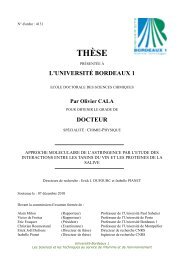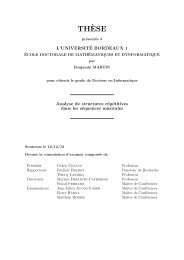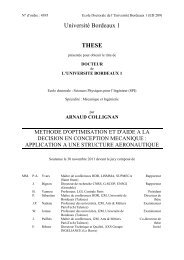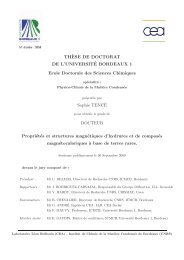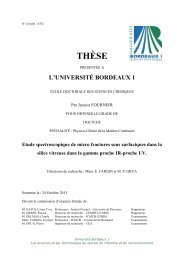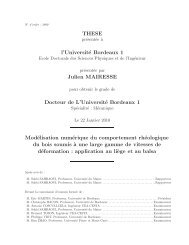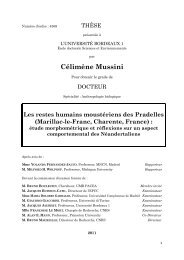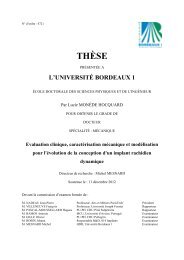de la structure à la croissance cellulaire - Université Bordeaux 1
de la structure à la croissance cellulaire - Université Bordeaux 1
de la structure à la croissance cellulaire - Université Bordeaux 1
You also want an ePaper? Increase the reach of your titles
YUMPU automatically turns print PDFs into web optimized ePapers that Google loves.
Résumé<br />
RESUME<br />
Le développement du fruit <strong>de</strong> tomate s’accompagne d’un phénomène d’endopolyploïdisation<br />
(amplification <strong>de</strong> l’ADN en l'absence <strong>de</strong> mitose) associé <strong>à</strong> <strong>la</strong> <strong>croissance</strong> cellu<strong>la</strong>ire. Au sta<strong>de</strong> vert<br />
mature huit niveaux <strong>de</strong> ploïdie sont présents (2C <strong>à</strong> 256C) dans le péricarpe.<br />
Une première partie du travail a porté sur l’étu<strong>de</strong> <strong>de</strong> <strong>la</strong> distribution spatiale <strong>de</strong>s niveaux <strong>de</strong><br />
ploïdie dans ce tissu. Cet objectif a nécessité <strong>la</strong> mise au point d’une métho<strong>de</strong> originale <strong>de</strong><br />
détermination <strong>de</strong> <strong>la</strong> ploïdie in situ reposant sur <strong>la</strong> technique <strong>de</strong> BAC-FISH. Nous avons montré que les<br />
cellules les plus polyploï<strong>de</strong>s se situent dans les assises internes du péricarpe, et qu’elles sont aussi<br />
les plus gran<strong>de</strong>s. Ces cellules semblent déj<strong>à</strong> formées au moment <strong>de</strong> l’anthèse. Cette cartographie <strong>de</strong><br />
<strong>la</strong> ploïdie associée <strong>à</strong> une analyse <strong>de</strong> <strong>la</strong> taille cellu<strong>la</strong>ire a également montré que <strong>la</strong> taille finale <strong>de</strong>s<br />
cellules ne dépend pas uniquement <strong>de</strong> leur niveau <strong>de</strong> ploïdie mais également <strong>de</strong> leur position dans le<br />
péricarpe. Enfin, nos résultats suggèrent que l’endopolyploïdisation précè<strong>de</strong> <strong>la</strong> <strong>croissance</strong> cellu<strong>la</strong>ire.<br />
Dans une <strong>de</strong>uxième partie du travail, nous avons étudié <strong>la</strong> <strong>structure</strong> <strong>de</strong>s noyaux en<br />
microscopie <strong>à</strong> fluorescence et électronique. L’endopolyploïdisation affecte profondément <strong>la</strong> taille et <strong>la</strong><br />
forme <strong>de</strong>s noyaux, qui acquièrent un volume important et une forme complexe avec <strong>de</strong> profon<strong>de</strong>s<br />
invaginations. La taille du nucléole augmente avec celle du noyau, ce qui suggère une activité <strong>de</strong><br />
transcription accrue. De plus, <strong>la</strong> présence <strong>de</strong> nombreuses mitochondries <strong>à</strong> proximité <strong>de</strong>s noyaux<br />
polyploï<strong>de</strong>s suggère une forte activité métabolique en lien avec l’endopolyploïdisation. L’utilisation <strong>de</strong><br />
<strong>la</strong> métho<strong>de</strong> BAC-FISH a permis également <strong>de</strong> montrer que <strong>la</strong> polyploïdie se faisait par<br />
endoreduplication avec <strong>la</strong> formation <strong>de</strong> chromosomes polytènes.<br />
Dans une troisième partie nous avons cherché, en crib<strong>la</strong>nt une banque <strong>de</strong> mutants Micro-<br />
Tom, <strong>à</strong> i<strong>de</strong>ntifier <strong>de</strong>s lignées affectées dans l’endoreduplication afin d’étudier l’impact <strong>de</strong> ce<br />
phénomène sur <strong>la</strong> vitesse <strong>de</strong> <strong>croissance</strong> du fruit. Nous avons caractérisé plusieurs familles dont les<br />
niveaux moyens <strong>de</strong> ploïdie variaient par rapport <strong>à</strong> <strong>la</strong> lignée <strong>de</strong> référence. Une <strong>de</strong> ces familles présente<br />
un phénotype stable au cours <strong>de</strong> <strong>de</strong>ux générations, avec une augmentation d’au moins 30 % <strong>de</strong> <strong>la</strong><br />
ploïdie moyenne et une augmentation <strong>de</strong> <strong>la</strong> taille <strong>de</strong>s cellules du péricarpe. Cependant cette famille<br />
présentant aussi un développement re<strong>la</strong>tivement parthénocarpique <strong>de</strong> ses fruits, sa caractérisation n’a<br />
pas pu être poursuivie dans le cadre <strong>de</strong> ce travail.<br />
Mots-clés : Tomate, endoréduplication, <strong>croissance</strong> cellu<strong>la</strong>ire, <strong>structure</strong> du noyau<br />
ABSTRACT<br />
Tomato fruit <strong>de</strong>velopment inclu<strong>de</strong>s massive endopolyploidisation events (DNA duplication in<br />
the absence of mitoses) within pericarp cells, in which 8 DNA levels from 2 C to 256 C are <strong>de</strong>tected at<br />
mature green stage.<br />
The first part of this work <strong>de</strong>alt with the study of the spatial distribution of ploidy levels in<br />
pericarp. To achieve this purpose, a new method for in situ ploidy assessment was set up using a<br />
BAC-FISH protocol. The main results are 1/ the most polyploid cells are located in central mesocarp<br />
cell <strong>la</strong>yers; 2/ the most polyploid cells are also the <strong>la</strong>rgest cells; 3/ these cells are likely to be already<br />
present in ovary at anthesis. Ploidy mapping has also shown that the final cell size does not <strong>de</strong>pend<br />
only on ploidy level but also on cell location in pericarp, and that endopolyploidization is likely set up in<br />
tissues before cell expansion.<br />
The <strong>structure</strong> of the polyploid nucleus was studied by using fluorescence microscopy and<br />
electron microscopy. Endopolyploidization profoundly modifies the size and shape of nuclei, which<br />
become much <strong>la</strong>rger and acquire a complex shape with <strong>de</strong>ep invaginations. Nucleolus size increases,<br />
which is likely re<strong>la</strong>ted to transcriptional increase. Moreover, the presence of numerous mitochondria in<br />
the close vicinity of the nuclear membrane reinforces the hypothesis of increased nuclear and<br />
metabolic activity in polyploid cells. The BAC-FISH in situ method for ploidy assessment also revealed<br />
that endopolyploidization procee<strong>de</strong>d through polyteny.<br />
In the <strong>la</strong>st part of this work, we screened a tomato Micro-Tom tilling bank for mutants affected<br />
in endopolyploidization. The aim was to use tomato lines with distinct ploidy levels to check the<br />
influence of ploidy on fruit growth rate. Several mutant families were i<strong>de</strong>ntified with mo<strong>de</strong>rately<br />
increased ploidy levels. One of these families exhibited transmissible phenotype through 2<br />
generations, with ploidy increased by ca. 30 % and increased pericarp cell size. As these mutants had<br />
also a strongly pronounced parthenocarpic phenotype, their characterization could not be further<br />
advanced in the frame of this work.<br />
Keywords : Tomato, endoreduplication, cell growth, nuclei <strong>structure</strong>



